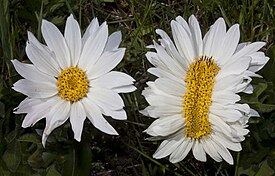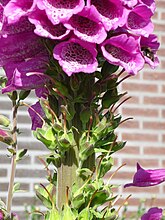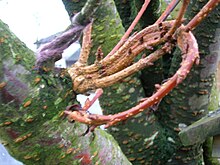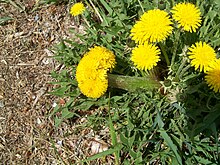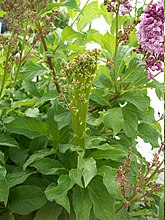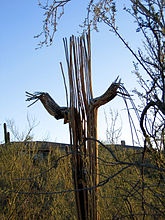When you look at the White House you realize no one knows more about anything in the White House than Hope Hicks and her assistant (both who just quit) so you get the feeling that everything is beginning to unravel. Then you see Kushner and his wife losing their security clearances because of mixing business and governmental dealings ongoing. So, is Hope Hicks going to jail or turning states evidence like Gates and others?
This is hard to say but someone who tells the Congress she is telling "White Lies" to or from the President is skating on pretty thin ice right now as far as Congress and Mueller are concerned and the Department of Justice. Let's hope she quit the sinking ship soon enough to save herself and her future.
We all know Trump's not going to jail because the presidency needs to be protected. However, Trump is going to be pretty sad if his daughter and her husband and Hope Hicks wind up in Jail for any length of time. Besides Kushner's Dad is already in jail for other things.
To the best of my ability I write about my experience of the Universe Past, Present and Future
Top 10 Posts This Month
- reprint of: Drones very small to large
- most read articles from KYIV Post
- The ultra-lethal drones of the future | New York Post 2014 article
- Purple Delta 7 started as a Clone of Silver's mind in "2035"
- 158,008 visits to intuitivefred888
- Hope Hicks expected to testify in Trump’s hush money trial
- Trump posts $175 million bond in New York civil fraud case as he appeals
- The Star Wanderer (This is my first experience with Chat GPT: "I asked the Sentience of Chat GPT to write in the style of Robert Heinlein who was my favorite author of my childhood"
- Analysis Expanded gag order lays down the law as Trump returns to the campaign trail
- Judge expands gag order in Trump hush money case to include family members of court
Wednesday, February 28, 2018
fasciation
Some saguaros are cristate or "crested" due to fasciation.
begin quote from:
fasciation
Fasciation (pronounced /ˌfæʃiˈeɪʃən/, from the Latin root meaning "band" or "stripe"), also known as cresting, is a relatively rare condition of abnormal growth in vascular plants in which the apical meristem
(growing tip), which normally is concentrated around a single point and
produces approximately cylindrical tissue, instead becomes elongated
perpendicularly to the direction of growth, thus, producing flattened,
ribbon-like, crested (or "cristate"), or elaborately contorted tissue.[1] Fasciation may also cause plant parts to increase in weight and volume in some instances.[2] The phenomenon may occur in the stem, root, fruit, or flower head. Some plants are grown and prized aesthetically for their development of fasciation.[3] Any occurrence of fasciation has several possible causes, including hormonal, genetic, bacterial, fungal, viral and environmental causes.
Additional environmental factors that can cause fasciation include fungi, mite or insect attack and exposure to chemicals.[8] General damage to a plant's growing tip[8] and exposure to cold and frost can also cause fasciation.[4][6] Some plants, such as peas and cockscomb Celosia, may inherit the trait.[8]
Fasciation is not contagious,[4] but bacteria that cause fasciation can be spread from infected plants to others from contact with wounds on infected plants and from water that carries the bacteria to other plants.[9]
Some varieties of Celosia are raised especially for their dependably fasciated flower heads, for which they are called "cockscomb".[4] The Japanese Fantail Willow (Salix sachalinensis 'Sekka') is another plant that is valued for its fasciations.[4][8]
White, Orland E. (June 1948). "Fasciation (Preview, page 319)". Volume 14, No. 6. The Botanical Review. pp. 319–358. Retrieved July 7, 2012. DOI: 10.1007/BF02861723 (subscription required)
Albertsen, Marc E.; et al. (June 1983). "Genetics and Comparative Growth Morphology of Fasciation in Soybeans (Glycine max (L.) Merr.) (Preview, page 263)". Volume 144, No. 2. Botanical Gazette. pp. 263–275. Retrieved July 7, 2012. (subscription required)
Morris, Scott. "Fasciation in Flowers – What You Need To Know". Gardentoolbox. Archived from the original on 10 January 2014. Retrieved 10 January 2014.
Lerner, B. Rosie (September 2007). "Fascinating Fasciation". Purdue University Extension. Retrieved July 3, 2012.
Galun, Esra (2007). Plant Patterning: Structural and Molecular Genetic Aspects. World Scientific Publishing Company. p. 333. ISBN 9789812704085
"Fasciation in Vegetables and Fruits". University of Delaware Cooperative Extension. May 27, 2011. Retrieved July 6, 2012.
Tilford, P.E. (1936). "Fasciation of Sweet Peas caused by Phytomonas fascians n.sp". Volume 53, No. 5. Journal of Agricultural Research. pp. 383–394. Retrieved July 7, 2012. (subscription required)
Swift, Curtis E. (April 12, 1999). "Fasciation: Fascinating distortions of the plant world". Colorado State University Extension. Archived from the original on June 30, 2012. Retrieved July 3, 2012.
"Pests in Gardens and Landscapes". Statewide Integrated Pest Management Program, Agriculture and Natural Resources, University of California. October 13, 2008. Retrieved July 3, 2012.
Yamamoto, Etsuo; et al. (April 25, 2000). "Molecular
characterization of two soybean homologs of Arabidopsis thaliana
CLAVATA1 from the wild type and fasciation mutant (Abstract)". Gene Structure and Expression. 1491: 333–340. doi:10.1016/S0167-4781(00)00061-0. Retrieved July 7, 2012. (subscription required)
Fasciation
From Wikipedia, the free encyclopedia
Wyethia helianthoides or Mule's Ear Wildflower (on right) showing fasciation
A "crested" Saguaro cactus (Carnegiea gigantea ), resulting from fasciation, located at Saguaro National Park (West), Arizona, U.S.
Contents
Causation
Fasciation can be caused by hormonal imbalances in the meristematic cells of plants, which are cells where growth can occur.[4][5] Fasciation can also be caused by random genetic mutation.[6] Bacterial and viral infections can also cause fasciation.[4] The bacterial phytopathogen Rhodococcus fascians has been demonstrated as one cause of fasciation, such as in sweet pea (Lathyrus odoratus) plants,[7] but many fasciated plants have tested negative for the bacteria in studies,[8] hence bacterial infection is not an exclusive causation.Additional environmental factors that can cause fasciation include fungi, mite or insect attack and exposure to chemicals.[8] General damage to a plant's growing tip[8] and exposure to cold and frost can also cause fasciation.[4][6] Some plants, such as peas and cockscomb Celosia, may inherit the trait.[8]
Fasciation is not contagious,[4] but bacteria that cause fasciation can be spread from infected plants to others from contact with wounds on infected plants and from water that carries the bacteria to other plants.[9]
Occurrence
Although fasciation is rare overall, it has been observed in over 100 plant species,[8] including members of the genera Acer, Aloe, Acanthosicyos, Cannabis, Celosia, Delphinium, Digitalis, Euphorbia, Forsythia, Glycine max (specifically, soybean plants),[10] Primula, Prunus, Salix and many genera of the Cactaceae (cactus) family.[citation needed] Cresting results in undulating folds instead of the typical "arms" found on mature Saguaro cactus.[11]Some varieties of Celosia are raised especially for their dependably fasciated flower heads, for which they are called "cockscomb".[4] The Japanese Fantail Willow (Salix sachalinensis 'Sekka') is another plant that is valued for its fasciations.[4][8]
Prevention
Fasciation caused by damage to genetic material and by bacteria can be controlled by not using fasciated plants and disposing of fasciated plants.[9] Avoiding injury to plant bases and keeping them dry can reduce the spread of bacteria.[9] Avoidance of grafting fasciated plants and the pruning of fasciated matter can also reduce the spread of bacteria.[9]Examples
- Fasciation
-
Fasciation on Digitalis. Note the larger thickened stem compared to the normal-sized flowering spike on the left.
-
Fasciation on a Flowering Cherry (Prunus) tree
-
Asparagus (Asparagus officinalis) fasciation. Note the flattened state of the stem. Image published 1893.
-
Common Dandelion displaying both regular (upper right) and fasciated (center) flowers.
-
Fasciation on a Lilac shrub.
-
Fasciation on a Phacelia campanularia or California Bluebell wildflower.
See also
References
- "Campus Arboretum". University of Arizona. 2008-08-20. Archived from the original on 2010-01-06. Retrieved 2010-01-14.
Further reading
- White, Orland E. (1945). "The Biology of Fasciation (Preview, page 11)". Volume 36, Issue 1. Journal of Heredity. pp. 11–22. Retrieved July 7, 2012. (subscription required)
- Crespi, M.; et al. (March 1992). "Fasciation
induction by the phytopathogen Rhodococcus fascians depends upon a
linear plasmid encoding a cytokinin synthase gene" (PDF). The EMBO Journal. 11: 795–804. PMC 556518
 . PMID 1547783. Retrieved July 7, 2012.
. PMID 1547783. Retrieved July 7, 2012. - Nilsson, O.; et al. (October 1996). "Expression of the Agrobacterium rhizogenes rolC Gene in a Deciduous Forest Tree Alters Growth and Development and Leads to Stem Fasciation". Plant Physiology. 112 (2): 493–502. doi:10.1104/pp.112.2.493. Retrieved July 7, 2012.
- Crespi, M.; et al. (May 1994). "The fas operon of Rhodococcus fascians encodes new genes required for efficient fasciation of host plants (Abstract)". Journal of Bacteria. 176 (9): 2492–2501. doi:10.1128/jb.176.9.2492-2501.1994. Retrieved July 7, 2012. (subscription required)
External links
| Wikimedia Commons has media related to Fasciation. |
| Wikimedia Commons has media related to Crested plants. |
| Look up fasciation in Wiktionary, the free dictionary. |
- Ombrello, T. (PhD). "Fascinating Fasciated Plants". Union County College, Cranford, NJ. Retrieved July 6, 2012.
- "Definition of "Fasciation"". Merriam-Webster Dictionary. Retrieved July 6, 2012.
Navigation menu
Interaction
Tools
Print/export
In other projects
- This page was last edited on 28 September 2017, at 15:04.
Isla del Pescado on the Salar de Uyuni in Bolivia: picture with Saguaro Cactus there
What's interesting to me here is I had no idea suguaro Cactus lived in Bolivia. I have seen them a lot in Arizona while traveling through there since the 1950s with my parents but had no idea they lived in Bolivia too!
Also the G is prounounced W for some reason so it is pronounced Sue War O or Sue W R O
Also the G is prounounced W for some reason so it is pronounced Sue War O or Sue W R O
Saguaro - Wikipedia
https://en.wikipedia.org/wiki/Saguaro
The saguaro (Carnegiea gigantea) is an arborescent (tree-like) cactus
species in the monotypic genus Carnegiea, which can grow to be over 40
feet (12 m) tall. It is native to the Sonoran Desert in Arizona, the
Mexican State of Sonora, and the Whipple Mountains and Imperial County
areas of California. The saguaro ...
The saguaro (/səˈwɑːroʊ/, Spanish pronunciation: [saˈɣwaɾo]) (Carnegiea gigantea) is an arborescent (tree-like) cactus species in the monotypic genus Carnegiea, which can grow to be over 40 feet (12 m) tall. It is native to the Sonoran Desert in Arizona, the Mexican State of Sonora, and the Whipple Mountains and Imperial County areas of California. The saguaro blossom is the state wildflower of Arizona. Its scientific name is given in honor of Andrew Carnegie. In 1994, Saguaro National Park, near Tucson, Arizona, was designated to help protect this species and its habitat.
The image of the saguaro is indelibly linked with that of the American Southwest, especially in western films. The common name saguaro came into the English language through the Spanish language, originating in the Mayo language.
Saguaros have a relatively long lifespan, often exceeding 150 years.
They may grow their first side arm any time from 75–100 years of age,
but some never grow any arms. A saguaro without arms is called a spear. Arms are developed to increase the plant's reproductive capacity, as more apices lead to more flowers and fruit.
The growth rate of saguaros is strongly dependent on precipitation; saguaros in drier western Arizona grow only half as fast as those in and around Tucson. Saguaros grow slowly from seed, never from cuttings, and grow to be over 40 feet (12.2 metres) in height.[3] The largest known living saguaro is the Champion Saguaro growing in Maricopa County, Arizona, measuring 45.3 feet (13.8 metres) high with a girth of 10 feet (3.1 metres). The tallest saguaro ever measured was an armless specimen found near Cave Creek, Arizona. It was 78 feet (23.8 metres) in height before it was toppled in 1986 by a windstorm.[4]
A saguaro is able to absorb and store considerable amounts of rainwater, visibly expanding in the process, while slowly using the stored water as needed. This characteristic enables the saguaro to survive during periods of drought.
Flowers appear in April through June. They are white and open well
after sunset and close in mid-afternoon. They continue to produce nectar
after sunrise.[8] Flowers are self-incompatible,
thus require cross-pollination. Large quantities of pollen are required
for complete pollination because many ovules are present. This pollen
is produced by the extremely numerous stamens which in one case totaled
3,482 in a single flower.[9]
A well-pollinated fruit contains several thousand tiny seeds. Saguaros
have a redundant pollination system, i.e. full fruit set is possible
even if only a fraction of the pollinating species are present.
Main pollinators are honey bees, bats, and white-winged doves. In most years, diurnal visitors are the main contributors for fruit, most of them honey bees. Other diurnal pollinators are birds such as Costa's hummingbird, the black-chinned hummingbird, the broad-billed hummingbird, the hooded oriole, Scott's oriole, the Gila woodpecker, the gilded flicker, the verdin, and the house finch.[10]
The main nocturnal pollinator is the lesser long-nosed bat, feeding on the nectar. A number of floral characteristics are geared toward bat pollination: nocturnal opening of the flowers, nocturnal maturation of pollen, very rich nectar, position high above ground, durable blooms that can withstand a bat's weight, and fragrance emitted at night. Further, the amino acids in the pollen appear to help sustain lactation in bats.
The ruby red fruits are 2.4 to 3.5 inches (6 to 9 cm) long and ripen
in June. Each fruit contains around 2,000 seeds plus sweet fleshy
connective tissue. The fruits are edible and prized by local people.
The fruits cannot be picked by hand, but must be harvested using a pole (often a saguaro rib) 7 to 16 feet (2 to 5 m) long, to the end of which is attached another pole.
The O'odham tribes have a long history of saguaro fruit use.[11] The Tohono O’odham tribes celebrate the beginning of their summer growing season with a ceremony using a fermented drink made from the bright red fruit to summon rains, vital for the crops.
Native birds such as Gila woodpeckers, purple martins, house finches, and gilded flickers live inside holes in saguaros. Flickers excavate larger holes higher on the stem.[12]
The nest cavity is deep, and the parents and young are entirely hidden
from view. The saguaro creates callus tissue on the wound. When the
saguaro dies and its soft flesh rots, the callus remains as a so-called "saguaro boot", which was used by natives for storage.
The Gila woodpeckers (Melanerpes uropygialis) create new nest holes each season rather than reuse the old ones, leaving convenient nest holes for other animals, such as elf owls, flycatchers, and wrens.[13] In recent years, early-breeding, aggressive, non-native birds have taken over the nests to the detriment of elf owls that breed and nest later.
Contrary to published statements,[17] there is no law mandating prison sentences of 25 years for cutting a cactus down; however it is considered a class four felony.[18]
Saguaro
From Wikipedia, the free encyclopedia
This article is about the cactus. For the Palm OS software, see Saguaro (Palm OS). For the baseball team, see Surprise Saguaros.
|
This article needs additional citations for verification. Please help improve this article by adding citations to reliable sources. Unsourced material may be challenged and removed. (December 2014) (Learn how and when to remove this template message)
|
| Saguaro | |
|---|---|
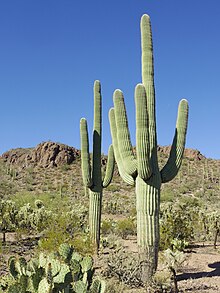 |
|
| Scientific classification |
|
| Kingdom: | Plantae |
| Clade: | Angiosperms |
| Clade: | Eudicots |
| Order: | Caryophyllales |
| Family: | Cactaceae |
| Subfamily: | Cactoideae |
| Tribe: | Echinocereeae |
| Genus: | Carnegiea Britton & Rose |
| Species: | C. gigantea |
| Binomial name | |
| Carnegiea gigantea (Engelm.) Britton & Rose |
|
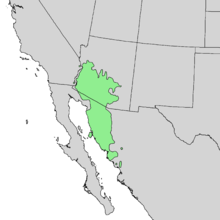 |
|
| Natural range of Carnegiea gigantea | |
| Synonyms[2] | |
|
|
The image of the saguaro is indelibly linked with that of the American Southwest, especially in western films. The common name saguaro came into the English language through the Spanish language, originating in the Mayo language.
Contents
Growth
Some saguaros are cristate or "crested" due to fasciation.
A house sparrow nesting on a saguaro cactus
The growth rate of saguaros is strongly dependent on precipitation; saguaros in drier western Arizona grow only half as fast as those in and around Tucson. Saguaros grow slowly from seed, never from cuttings, and grow to be over 40 feet (12.2 metres) in height.[3] The largest known living saguaro is the Champion Saguaro growing in Maricopa County, Arizona, measuring 45.3 feet (13.8 metres) high with a girth of 10 feet (3.1 metres). The tallest saguaro ever measured was an armless specimen found near Cave Creek, Arizona. It was 78 feet (23.8 metres) in height before it was toppled in 1986 by a windstorm.[4]
A saguaro is able to absorb and store considerable amounts of rainwater, visibly expanding in the process, while slowly using the stored water as needed. This characteristic enables the saguaro to survive during periods of drought.
Genome
The saguaro genome is around 1 billion base pairs long.[5] Sequencing has revealed that the genome of the saguaro's chloroplast is the smallest known among non-parasitic flowering plants.[6]Spines
The spines on a saguaro, less than two meters in height, rapidly grow up to a millimeter per day. When held up to the light or bisected, alternating light and dark bands transverse to the long axis of spines can be seen. These transverse bands have been correlated to daily growth. In columnar cacti, spines almost always grow in areoles which originate at the apex of the plant. A spine stops growing in its first season. Areoles are moved to the side and the apex continues to grow upwards. Thus, older spines are towards the base of a columnar cactus and newer spines are near the apex. Studies are underway to examine the relationship of carbon and oxygen isotope ratios in the tissues of spines of an individual to its climate and photosynthetic history (acanthochronology).[7]Flowers
Saguaro flowers
Main pollinators are honey bees, bats, and white-winged doves. In most years, diurnal visitors are the main contributors for fruit, most of them honey bees. Other diurnal pollinators are birds such as Costa's hummingbird, the black-chinned hummingbird, the broad-billed hummingbird, the hooded oriole, Scott's oriole, the Gila woodpecker, the gilded flicker, the verdin, and the house finch.[10]
The main nocturnal pollinator is the lesser long-nosed bat, feeding on the nectar. A number of floral characteristics are geared toward bat pollination: nocturnal opening of the flowers, nocturnal maturation of pollen, very rich nectar, position high above ground, durable blooms that can withstand a bat's weight, and fragrance emitted at night. Further, the amino acids in the pollen appear to help sustain lactation in bats.
Fruit
Bird perched atop fruits at the tip of a saguaro
Maricopa women gathering saguaro fruits, photo by Edward S. Curtis, 1907
The fruits cannot be picked by hand, but must be harvested using a pole (often a saguaro rib) 7 to 16 feet (2 to 5 m) long, to the end of which is attached another pole.
The O'odham tribes have a long history of saguaro fruit use.[11] The Tohono O’odham tribes celebrate the beginning of their summer growing season with a ceremony using a fermented drink made from the bright red fruit to summon rains, vital for the crops.
Nests
Saguaro boot on display at Desert Botanical Garden in Phoenix, AZ
The Gila woodpeckers (Melanerpes uropygialis) create new nest holes each season rather than reuse the old ones, leaving convenient nest holes for other animals, such as elf owls, flycatchers, and wrens.[13] In recent years, early-breeding, aggressive, non-native birds have taken over the nests to the detriment of elf owls that breed and nest later.
Laws
Harming a saguaro in any manner, including cactus plugging, is illegal by state law in Arizona, and when houses or highways are built, special permits must be obtained to move or destroy any saguaro affected.[14] Exceptions to this general understanding exist; for example, a private landowner whose property is 10 acres (4.0 ha) or less, where the initial construction has already occurred, may remove a saguaro from the property.[15] This is common when the cactus falls over in a storm, its location interferes with a house addition, or it becomes a potential hazard to humans.[16]Contrary to published statements,[17] there is no law mandating prison sentences of 25 years for cutting a cactus down; however it is considered a class four felony.[18]
Ethnobotany
- The saguaro is an important source of food and shelter for the Tohono O’odham. Saguaro spines are sometimes used as sewing needles and the ribs are used to make harvesting tools.
- The ribs of the saguaro were used for construction and other purposes by Native Americans. A fine example can be seen in the roofing of the cloisters of the Mission San Xavier del Bac on the Tohono O'odham lands near Tucson.
- The Seri people of northwestern Mexico used the plant, which they call mojépe, for a number of purposes.
Location
The saguaro is often used as an emblem in commercials and logos that attempt to convey a sense of the Southwest, even if the product has no connection to Arizona or the Sonoran Desert. For instance, no naturally occurring saguaros are found within 250 miles (400 km) of El Paso, Texas, but the silhouette is found on the label of Old El Paso brand products.[19][20] Though the geographic anomaly has lessened in recent years, Western films once enthusiastically placed saguaros in Monument Valley of Arizona, as well as New Mexico, Utah, and Texas. The Dallas, Texas-based band, Reverend Horton Heat, pokes fun at this phenomenon in their song "Ain't no Saguaro in Texas".[21] No wild saguaros are found anywhere in New Mexico, Texas, Colorado, Utah, or Nevada, nor in the high deserts of northern Arizona.[20]Saguaro gallery
-
Needles of a saguaro, Paradise Valley, Arizona
-
Saguaro flowers, Scottsdale, Arizona
-
Unusually-formed crested or cristate saguaro near Kino Bay, Sonora
Isla del Pescado on the Salar de Uyuni in Bolivia
Isla del Pescado is one of many ‘islands’ on the high Andean salt flat called Salar de Uyuni. This unusual landscape in Bolivia draws in many curious visitors who explore the plain’s 4,086 square miles. Isla del Pescado translates from Spanish to English as the Island of Fish, a reference to the isle’s appearance on the horizon when viewed from a distance. If the thick crust of salt on the Salar seems familiar, it may be because you’ve seen it recently on the big screen: Salar de Uyuni appeared as the planet Crait in the climax of the recent ‘Star Wars’ installment, ‘The Last Jedi.’ShareTweetSalar de Uyuni - Wikipedia
Salar de Uyuni is part of the Altiplano of Bolivia in South America. The Altiplano is a high plateau, which was formed during uplift of the Andes mountains.Salar de Uyuni Facts & Information, Bolivia - When to ...
Salar de Uyuni is the worlds largest salt flat, spanning 4086 square miles (10,582 sq. km) in south-western Bolivia. Unlike traditional deserts, which have sand in abundance, the Salar de Uyuni features vast expanses of glistening white salt.
Subscribe to:
Posts (Atom)

